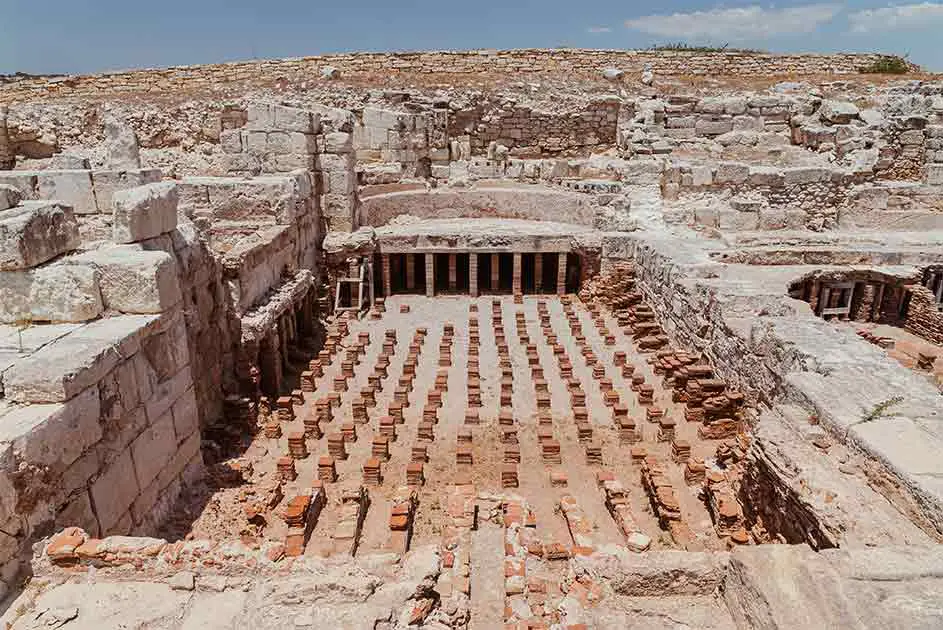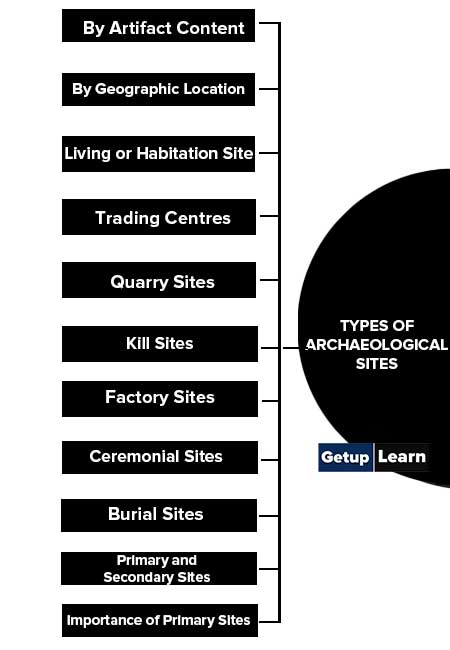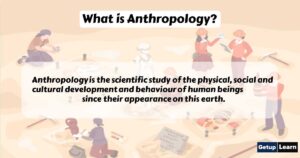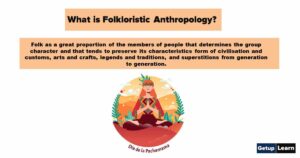Table of Contents
What are Archaeological Sites?
A ‘Site’ or precisely an archaeological site is any kind of place, large or small, where there are traces of human occupation or activity found available. Archaeological sites consist essentially of activity areas that comprise material cultural objects like tools and remains of food in the form of rubbish dumps.

Table of Contents
Sites do not remain intact rather they change in course of time either through the repeated occupation of man or due to the impact of various natural agencies. They however remain intact on many occasions after the site is discarded and abandoned.
Types of Archaeological Sites
These are the types of archaeological sites given below:
- By Artifact Content
- By Geographic Location
- Living or Habitation Site
- Trading Centres
- Quarry Sites
- Kill Sites
- Factory Sites
- Ceremonial Sites
- Burial Sites
- Primary and Secondary Sites
- Importance of Primary Sites
- Abandonment of a Site

By Artifact Content
The association, assemblages, and sub assemblages of artefacts in the sites are used to label it as Stone Age, Chalcolithic, or Iron Age, and so on. Thus the particular site can be labelled according to its specific artefacts content: stone tools, milling stones, pottery, and some metal artefacts.
On the other hand, the sub assemblages recovered from the site reflect individual human behaviour, sites can be classified by the characteristic pattern of the artefacts found in them such as burial sites, kill or butchering sites, quarry sites and habitation sites.
By Geographic Location
Many human settlements are well-defined types associated to various geographic locations, and these sites can be referred as open sites, lakeside sites, cave sites, valley sites, foothill sites, and so on.
The above-mentioned sites could be expanded, but none of them can singly account for all the possible kinds of sites. The study of all kinds of sites is relevant to a particular objective pertaining to any research to give a holistic picture of the social system operative in prehistory.
Therefore it is meaningless to attribute that some kinds of sites are of more value than others. It is fairer to attribute that some kinds of sites yield a greater range of information than do the others and that consequently, these are the sites most often studied.
Living or Habitation Site
Habitation sites are the most important sites because people have lived and carried out a multitude of activities at the place. The most commonly excavated sites are the places where people lived and these sites were a focal point of prehistoric activities. All archaeological sites imply habitation though it may have been for a relatively short time period.
A habitation site is one around which a group of people-centred their daily activities. The artefacts in living sites reflect domestic activities such as food production. Habitation sites that were occupied the year-round frequently have the remains of houses, but dwellings may be caves or rock shelters or even open areas in which no trace of a permanent shelter remains.
Sites that are ordinarily close to settlements are agricultural fields and terraces, irrigation canals, roads, bridges, aqueducts, and cemeteries. Occasionally habitation sites served the dual purpose of dwelling and defence, although defensive structures are relatively rare in prehistoric times.
Trading Centres
A number of trading sites have been reported from a few places, though it is difficult to recognise them with certainty. Sites centrally situated between the Maya and Aztec areas have been identified as ports of trade, though of course, they were habitation sites as well. The site Lothal in the Indus area is also of the same type.
Archaeologists have found a site on nonarable land that was favourably placed for the salt and obsidian trade in Turkey. Pathways across open ground or roads such as the Roman roads of Britain and Inca highways are distinguished features related to trade.
Teotihuacan near Mexico City is the great prehistoric metropolis that covers about 20 square kilometres with a population estimated Space as high as 125,000 persons. There are certain groups of buildings where foreign pottery is abundant and the archaeologists think that merchants from the Gulf Coast, Yucatan, and Oaxaca may have lived in the area.
Quarry Sites
In archaeological terms, a quarry or mine site is where there was evidence of material, such as stone or metal ore were mined for use as building material or for tool manufacture. Quarries are interesting to archaeologists because the sources of raw materials found on archaeological sites help to know trade networks of prehistoric and protohistoric people.
Evidence at a quarry might also show available technology in the form of tools left behind and cut marks in the walls of the excavation pits.
Kill Sites
Kill sites are places where prehistoric people killed games and camped around while butchering the meat. They are relatively common on the Great Plains. It is common in the United States to found kill sites, places where one or more animals were killed by hunters, some of whom may have had no permanent dwellings.
At kill sites, archaeologists find the bones of the animals, projectile points used for killing them, and the tools for butchering. In some cases where the bone materials have been well preserved the pattern of butchering the animals can be reconstructed. At Olduvai, one such site is found.
Outside the Americas, it is less common to find kill sites, though certain remains from the Acheulian and later periods, situated at the edges of rivers and lakes must have been the combination of kill and habitation sites. Those hunters usually have a home base from which they wander in pursuit of game and often bring back only the edible portion of butchered animals.
The amount of bone and stone tools in these sites suggests seasonal or perhaps permanent year-round camps. Archaeologist usually calls these sites “living floors”. Frequently a fireplace is found in which the meat was cooked.
Factory Sites
The factory site is a site where men manufacture tools. These sites are generally located near the sources of raw material. Numerous factory sites have been discovered in India.
Example of Lower Palaeolithic factory sites is Chirki on the valley of the river Pravara, Gangapur on the river Godavari, Chitor in Rajasthan. Several factory sites were also used by men as campsites or living sites. The raw materials finished and unfinished tools, debitage are the indicator of the factory site.
Ceremonial Sites
A ceremonial site may or may not be integral to a living site. Mayan ceremonial sites, such as Tikal were surrounded by habitation areas. Ceremonial sites include the imposing megalithic construction at Stonehenge. Ceremonial sites are found in much older caves in France and Spain where remarkable paintings, carvings, and reliefs are found.
Ordinarily, however, there are no dwellings other than those of political or religious officials and their retainers within the area of a ceremonial site. For example, La Venta, a large Meso American ceremonial centre, was erected some distance away from the area where the general population lived.
Burial Sites
Burial sites are mostly those sites where the dead bodies are ceremonially buried. Burial sites include both cemeteries and isolated tombs. People have been burying their dead since at least 100,000 years ago and have often taken enormous pains to prepare them for the afterlife. The most famous burial sites of all are the pyramids of Giza in Egypt.
Archaeologist concentrates their efforts on cemeteries because they often contain useful information about social practices. Burial sites range from isolated burials in shallow holes to elaborate masonry construction, earth mounds, and megalithic monuments.
At the classic Maya site of Palenque in the state of Chiapas, Mexico, the pyramid and temple of the inscriptions were built over a great burial chamber, and subsequently, several other examples of tombs in the pyramids have been found. Many burials are associated with special grave furniture, jewellery and ornaments of rank.
Primary and Secondary Sites
The site may be either primary if people have deposited their own remains there or secondary if the remains have been redeposited by other people or by the natural agency. Any other human disturbance of the ground might result in elements of the site being moved around and redeposited.
For example, a primary deposit on a river terrace has been bulldozed into another part of the terrace; the place of redeposition is a secondary site.
Importance of Primary Sites
A primary site may either be disturbed or none disturbed. The living sites are mainly primary sites. If at a site the evidence of cultural material left behind by man is found in an undisturbed or original deposition or in –situ position it is primary site.
The material remains recovered from these sites provide valuable information about the life of the people who lived there as well as about their surroundings. The present trend of India is more towards exploring and excavating the primary or the living sites. The contents of the primary site comprise both natural and human deposits.
The natural deposits consist of materials laid down by water, wind or other geological agencies. The human deposits cover the animal deposition and material culture.
Abandonment of a Site
At some stage in the life of an activity area, a settlement may be abandoned. All features of the site, such as pits, buildings, roads would be abandoned but also a range of artefacts. Once a site has been abandoned other communities in the area may see it as useful local resources of firewood or building materials.
The site could be levelled further for new buildings and cut away to make terraces for new houses or agriculture.
FAQs about Archaeological Sites
What are the types of archaeological sites?
The following are the types of archaeological sites:
1. By Artifact Content
2. By Geographic Location
3. Living or Habitation Site
4. Trading Centres
5. Quarry Sites
6. Kill Sites
7. Factory Sites
8. Ceremonial Sites
9. Burial Sites
10. Primary and Secondary Sites
11. Importance of Primary Sites
12. Abandonment of a Site
YOU MIGHT ALSO LIKE
- What is Anthropology?
- Branches of Anthropology
- What is Social Anthropology?
- Scope of Social Anthropology
- Nature of Social Anthropology
- What is Social Cultural Anthropology?
- Theories of Sociocultural Anthropology
- What are Archaeological Sites?
- Types of Archaeological Sites
- What is Linguistic Anthropology?
- What is Marriage?
- Types of Marriage
- What is Family?
- Types of Family in Sociology
- Functions of the Family
- Folk literature
- What is Biological Anthropology?
- Biological Anthropology Fields of Study
- What is Social Anthropology?
- Definition of Social Anthropology
- Scope of Social Anthropology
- Nature of Social Anthropology
- What is archaeology?
- What is Archaeological Anthropology?
- Process of Archaeology
- Types of Archaeology Sites
- Linguistics Language
- Linguistic Culture
- Types of Marriages
- What is Kinship?
- Types of Kinship Groups
- What is Folkloristic Anthropology?











